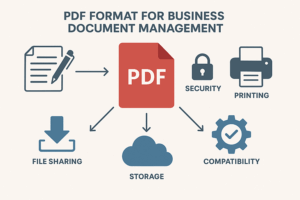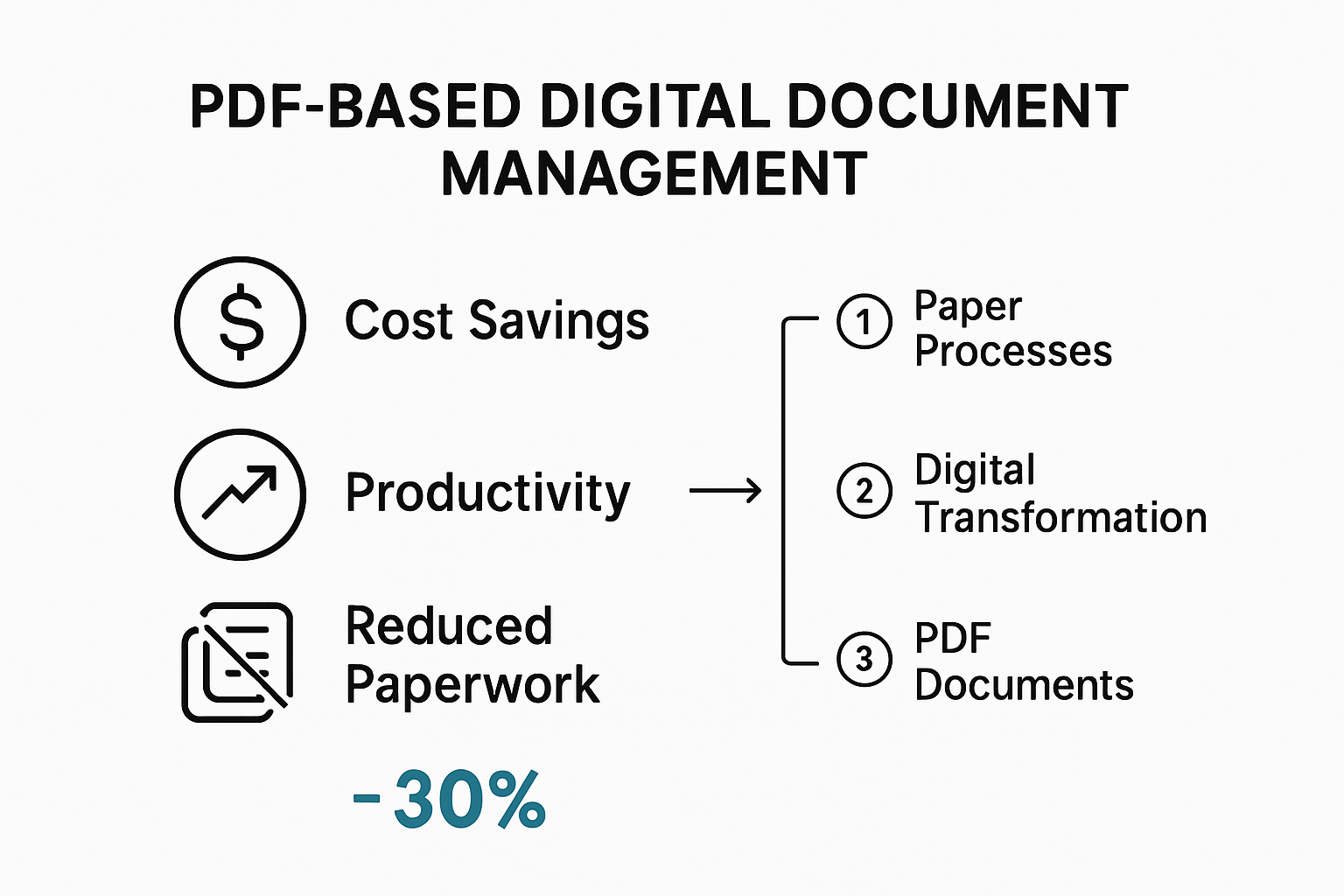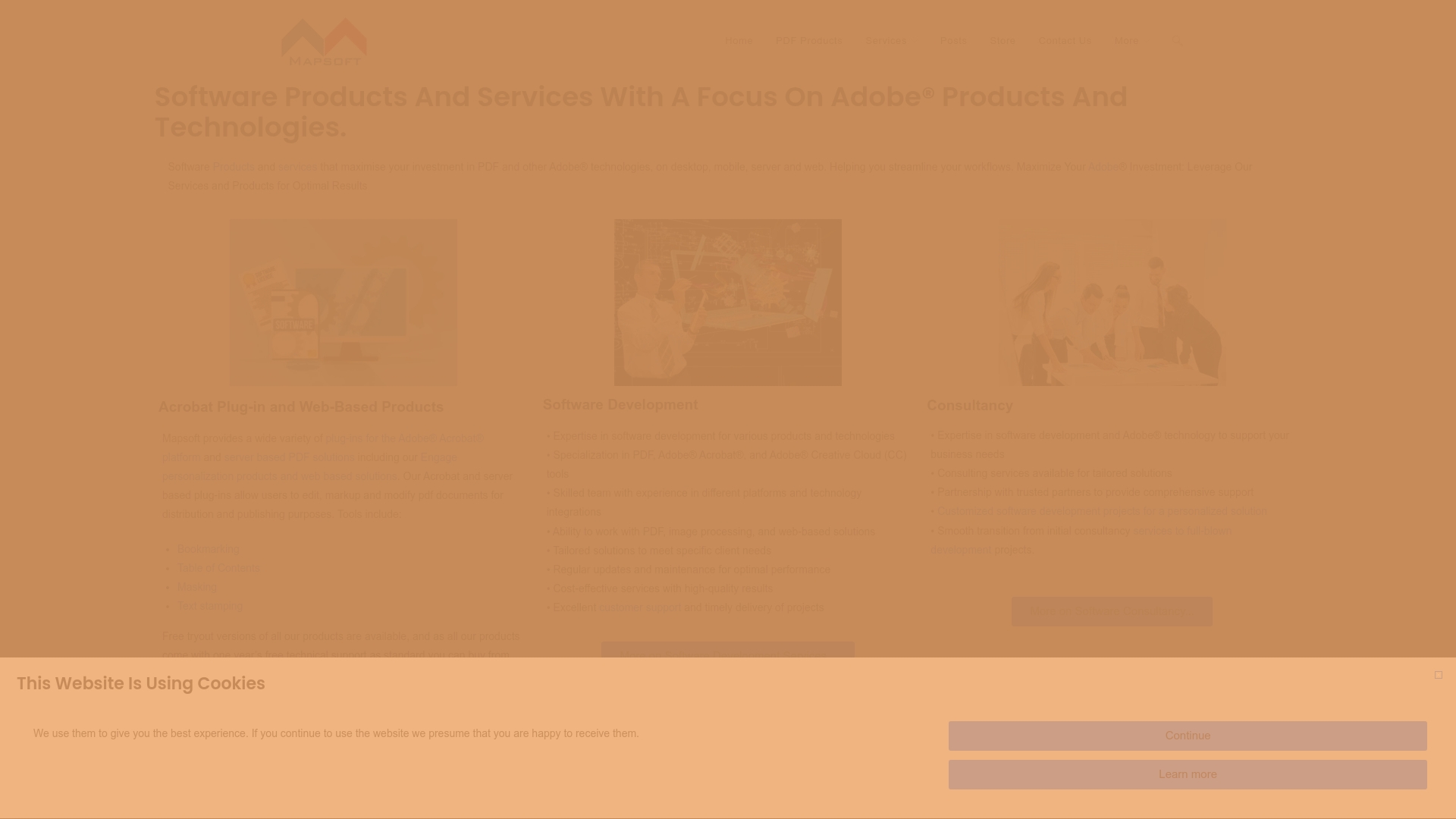PDF files might seem like simple document containers, but they are the backbone of serious business workflows. More than 90% of global businesses use PDFs as their primary document exchange format, yet most users barely scratch the surface of what this format can do. Understanding why use pdf format reveals the real surprise: PDFs can slash costs, tighten security, and automate mountain-sized paperwork—it goes way beyond convenient file sharing.

Table of Contents
- Pdf Format Ensures File Security And Compliance
- Effortless Sharing And Universal Compatibility
- Streamlining Document Workflows With Pdf Tools
- Reducing Costs And Boosting Productivity With Pdfs
Quick Summary
| Takeaway | Explanation |
|---|---|
| PDF format enhances document security | PDFs provide password protection, encryption, and access controls to safeguard sensitive data. |
| PDF ensures compliance with regulations | The format meets legal standards for various industries, protecting documents for long-term preservation. |
| Seamless sharing promotes collaboration | PDFs maintain formatting across devices, making it easy to share and collaborate without issues. |
| Automation boosts workflow efficiency | PDF tools enable document processing automation, reducing administrative tasks and speeding up operations. |
| Digital transformation reduces costs | Transitioning to PDF-based systems cuts expenses related to physical storage and document handling. |
PDF Format Ensures File Security and Compliance
Businesses require document formats that protect sensitive information while maintaining compliance with various regulatory standards. PDF format emerges as a critical solution for organizations seeking robust security and regulatory adherence in their document management processes.
The following table summarizes the key advanced security features provided by the PDF format, as discussed in this section. This helps readers quickly identify the main protection mechanisms available when managing sensitive documents:
| Security Feature | Description |
|---|---|
| Password Protection | Restricts document access to authorized users only |
| Encryption | Encodes document content to prevent unauthorized viewing |
| Access Controls | Limits actions like editing, copying, or printing by user |
| Granular Permissions | Sets restrictions on specific sections or functions |
| Modification Tracking | Logs changes for audit trails and accountability |
Advanced Security Features for Sensitive Documents
PDF documents provide multiple layers of security that protect critical business information from unauthorized access and manipulation. Organizations can implement password protection, encryption, and access controls directly within the PDF file structure. Learn more about document version control to understand how these security mechanisms work in enterprise environments.
The U.S. Department of Energy highlights that properly constructed PDFs must be accessible and readable, which means creating documents that not only protect information but also maintain usability. According to their web requirements guidelines, PDFs should be machine-readable and comply with accessibility standards.
Regulatory Compliance and Long-Term Preservation
Regulatory environments across industries demand strict document management protocols. PDFs offer a standardized format that meets compliance requirements for healthcare, finance, government, and legal sectors. The National Archives and Records Administration mandates specific PDF configurations to ensure long-term digital preservation and legal authenticity.
Companies can leverage PDF/A standards, which are specifically designed for archival purposes. Long-term PDF archiving solutions enable organizations to create documents that remain readable and verifiable decades after initial creation. This format prevents file corruption, ensures consistent rendering across different platforms, and maintains the original document’s integrity.
Comprehensive Document Protection Strategies
Effective PDF security extends beyond simple password protection. Advanced PDF formats allow organizations to implement granular access controls, track document modifications, and prevent unauthorized editing or printing. Businesses can set permissions that restrict copying, printing, or editing of specific document sections, providing unprecedented control over sensitive information.
By choosing PDF as a primary document format, companies can create a robust framework for information protection. The format’s built-in security features, combined with its widespread compatibility, make it an ideal solution for businesses seeking comprehensive document management strategies that balance accessibility with stringent security requirements.
Enterprise-level document management demands more than just a file format. PDF represents a sophisticated approach to information protection, offering organizations a reliable method to secure, preserve, and control their critical business documents across complex technological ecosystems.
Why use PDF format for Effortless Sharing and Universal Compatibility
In the modern business environment, document compatibility and seamless sharing are critical for maintaining productive workflows. PDF format stands out as a universal solution that transcends software, platform, and device limitations, enabling organizations to communicate and collaborate efficiently.
Cross Platform Document Accessibility
PDF documents provide unparalleled compatibility across different operating systems, devices, and software applications. Whether a team member uses Windows, macOS, Linux, or mobile platforms like iOS and Android, PDF files render consistently without formatting issues. Explore our document workflow solutions to understand how PDFs streamline interdepartmental communication.
This table provides a comparison of PDF document features that support effortless sharing and universal compatibility, helping readers understand how PDFs facilitate business communication across platforms and devices:
| Feature | Benefit |
|---|---|
| Cross-Platform Accessibility | Consistent rendering on Windows, macOS, Linux, iOS, Android |
| Format Preservation | Maintains layout, fonts, images, and formatting |
| Digital Signatures | Enables secure approvals and authentication |
| Comment & Annotation Support | Allows for collaborative reviews and feedback |
| Secure Cloud Sharing | Facilitates safe, remote document distribution |
According to Adobe’s Compatibility Report, over 90% of global businesses rely on PDF as their primary document exchange format, demonstrating its widespread acceptance and reliability. This universal support eliminates the traditional barriers of file incompatibility that have long plagued business communications.
Preserving Document Integrity During Sharing
Unlike editable formats like Word or Excel, PDFs maintain their original layout, fonts, images, and formatting regardless of the viewing device or software. This preservation ensures that complex documents with intricate designs, technical diagrams, or specialized formatting remain exactly as the creator intended.
The National Institute of Standards and Technology recommends PDF as a standardized format for document preservation, highlighting its ability to maintain visual and structural consistency across diverse technological environments.
Advanced Sharing and Collaboration Features
Modern PDF technologies offer sophisticated sharing capabilities beyond simple file transmission. Businesses can leverage features like digital signatures, comment tracking, form interactions, and secure cloud sharing. These capabilities transform PDFs from static documents into dynamic collaboration tools.
Enterprise teams can annotate, review, and collaborate on PDF documents in real-time, regardless of geographical location or individual software preferences. This flexibility promotes more efficient communication and reduces the friction traditionally associated with document sharing and review processes.
By embracing PDF as a primary document format, organizations unlock a powerful tool for seamless information exchange. Its universal compatibility, consistent rendering, and advanced sharing features make PDF an indispensable solution for businesses seeking to optimize their document management and communication strategies.
Streamlining Document Workflows with PDF Tools
In today’s fast-paced business environment, organizations need robust tools that transform complex document processes into efficient, automated workflows. PDF tools have emerged as powerful solutions that enable businesses to optimize document management, reduce manual tasks, and accelerate productivity across various operational domains.
Intelligent Document Processing and Automation
Advanced PDF technologies now incorporate intelligent document processing capabilities that go far beyond simple file conversion. Discover advanced PDF automation techniques to understand how businesses can dramatically reduce administrative overhead.
According to research published on arXiv, intelligent document processing methods are revolutionizing how organizations handle complex documentation. These systems can automatically classify documents, extract critical information, and seamlessly integrate data into existing business processes, dramatically reducing human intervention and potential errors.
Workflow Optimization Through PDF Tools
Modern PDF tools provide comprehensive features that transform document management from a time-consuming task into a streamlined, efficient process. Businesses can leverage automated actions that perform repetitive tasks such as merging multiple documents, extracting specific pages, applying consistent formatting, and routing files to designated locations.
For small businesses seeking operational efficiency, SCORE recommends digitizing physical documents and implementing robust document management systems. PDF tools enable organizations to create searchable archives, track document versions, and maintain comprehensive audit trails with minimal manual effort.
Advanced Collaboration and Process Integration
Enterprise-grade PDF tools now offer sophisticated integration capabilities that connect document workflows with broader business systems. Organizations can create custom automation scripts, develop intelligent routing mechanisms, and implement complex approval workflows that span multiple departments and technological platforms.
Explore workflow automation with Adobe Acrobat’s advanced actions to understand how businesses can create repeatable, consistent document processing strategies. These tools enable teams to design custom workflows that adapt to specific organizational requirements, reducing bottlenecks and improving overall operational efficiency.
By embracing PDF tools as a core component of document management strategy, businesses can transform their administrative processes. The combination of intelligent processing, automation capabilities, and seamless integration represents a powerful approach to managing increasingly complex information ecosystems. PDF tools are no longer just file format utilities but strategic assets that drive organizational productivity and innovation.

Reducing Costs and Boosting Productivity with PDFs
Businesses constantly seek strategies to optimize operational expenses while maintaining high productivity levels. PDF technologies have emerged as a powerful solution for organizations looking to streamline document management, reduce administrative overhead, and create more efficient workflows.
Digital Transformation and Cost Reduction
Implementing PDF-based document management represents a significant opportunity for cost savings. Learn about automating business processes to understand how digital document strategies can dramatically reduce operational expenses. The transition from paper-based to digital document systems eliminates numerous hidden costs associated with traditional document handling.
According to research on digital mailroom technologies, converting physical documents to digital formats like PDFs can significantly reduce decision-making cycles and minimize expenses related to physical document storage, printing, and distribution. Organizations can save substantial resources by eliminating paper-based processes and embracing digital document management.

Intelligent Document Processing and Productivity
Modern PDF technologies incorporate intelligent document processing capabilities that dramatically enhance organizational productivity. Research published on arXiv highlights how intelligent document processing methods can automatically classify documents, extract critical information, and integrate data into business processes with minimal human intervention.
Cloud-based document conversion services enable businesses to handle large document volumes efficiently. Cloud document processing research demonstrates how high-throughput document conversion can lead to improved operational responsiveness and reduced processing times. By leveraging PDF technologies, organizations can transform time-consuming administrative tasks into streamlined, automated workflows.
Strategic Collaboration and Resource Optimization
PDF tools facilitate more than just document management. They enable strategic collaboration that directly impacts organizational productivity. Explore collaborative strategies for modern teams to understand how advanced PDF technologies support more efficient team interactions and resource allocation.
By reducing manual document handling, minimizing printing costs, and enabling faster information sharing, PDF technologies help businesses allocate human resources more strategically. The cumulative effect of these efficiency gains translates into significant cost savings and improved organizational performance.
Enterprise-level document management is no longer about simply storing information. It is about creating intelligent, responsive systems that adapt to organizational needs. PDF technologies represent a critical component of this digital transformation, offering businesses a sophisticated approach to managing information resources while maintaining strict cost control and productivity standards.
Frequently Asked Questions
What are the security features of PDF format for business documents?
PDF format includes advanced security features such as password protection, encryption, and access controls that help protect sensitive data from unauthorized access and manipulation.
How does PDF format ensure compliance with regulations?
PDF format meets regulatory compliance standards for various industries, including healthcare and finance, by providing a standardized format that supports long-term preservation and legal authenticity.
Can PDF files be shared across different platforms?
Yes, PDF files can be shared effortlessly across various operating systems and devices while maintaining their integrity and formatting, making them ideal for business communication.
How can PDF tools streamline document workflows?
PDF tools automate repetitive tasks, enhance collaboration, and enable intelligent document processing, significantly improving overall workflow efficiency and reducing administrative overhead.
Transform Your PDF Workflows With Mapsoft Solutions
Is your current PDF process slowing down your team or leaving gaps in compliance and document security? The article highlighted real problems businesses face: manual document tasks drain productivity. Sensitive data demands top-tier protection. Seamless collaboration is a must, but without the right tools, managing and sharing business documents remains frustrating and risky.

Mapsoft.com empowers you to eliminate these pain points. Our advanced PDF tools help you automate complex workflows, enforce regulatory compliance, and keep every document secure and accessible across platforms. Discover how features like batch automation, intelligent document processing, and deep integration with Adobe Acrobat put you in control. Take the next step toward effortless document management. Visit Mapsoft.com to see how our solutions help you unlock the full power of PDF for your business. Or dive deeper into automating business processes with Adobe PDF solutions to discover tailored tools that boost your productivity today.
Recommended
- Automating Business Processes with Adobe PDF Solutions – Mapsoft
- Confident Bulk PDF Conversion Solutions for Modern Businesses
- Document Version Control for Businesses in 2025: Best Practices and Adobe Solutions – Mapsoft
- Exciting PDF Accessibility Guidelines for Business Empowerment
Conclusion
- As organizations evolve, they must continually ask why use pdf format to ensure best practices are upheld.
- By understanding why use pdf format, you can enhance your document workflow significantly.
- In conclusion, the question of why use pdf format remains crucial for future-proofing a business’s documentation strategy.
- Another reason why use pdf format is its compatibility with numerous applications.
- Exploring why use pdf format brings significant advantages for long-term document storage.
- Therefore, understanding why use pdf format is essential for improving document workflows.
- To sum up, many users ask why use pdf format as their go-to solution for documents.
- For many companies, the decision on why use pdf format stems from the need for reliable document exchange.
- There is no question that knowing why use pdf format can provide a competitive edge.
- Moreover, understanding why use pdf format helps in streamlining communication across departments.
- When businesses analyze why use pdf format, they often find that it enhances operational efficiency.
- It’s essential to explore why use pdf format in every industry for document preservation. Why use pdf format? It is the preferred choice for many organizations.
- This is especially true when understanding why use pdf format can lead to improved compliance with regulatory requirements.
- Every organization should consider why use pdf format as their primary document handling method. Why use pdf format? It simplifies workflows and enhances security.
- Understanding why use pdf format allows businesses to choose the most effective documentation solution. Why use pdf format? It’s not just about compatibility; it’s about security, efficiency, and collaboration.
- Companies consistently ask why use pdf format for their documentation needs.
- One of the reasons to understand why use pdf format is its ability to maintain document integrity.
- Understanding why use pdf format is essential for effective document management.



